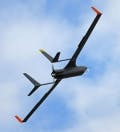Marines choose Insitu Integrator UAV to meet Small Tactical Unmanned Air System (STUAS)/Tier II requirements
LAKEHURST, N.J., 30 July 2010. The U.S. Marine Corps is choosing the Integratorunmanned aerial vehicle (UAV) from Insitu Inc. in Bingen, Wash., to meet the service's Small Tactical Unmanned Air System (STUAS)/Tier II requirements. The U.S. Naval Air Warfare Center Aircraft Division in Lakehurst, N.J., awarded a $43.7 million contract to Insitu Thursday to begin full-scale development of the Integrator UAV for the Marine Corps.
Integrator provides battlefield commanders with round-the-clock real-time intelligence, surveillance, and reconnaissance (ISR) through an electro-optical and infrared sensor package from Hood Technology Corp. in Hood River, Ore. Sensors transmit high-resolution imagery via an encrypted line-of-sight digital data link from L-3 Communication Systems-West in Salt Lake City. Harris Corp. in Melbourne, Fla., is providing the communications relay payload to support secure ground communications.
Insitu will begin the 24-month engineering, manufacturing and development phase to build and test its Integrator to ensure it meets STUAS/Tier II system requirements. Insitu partners are The Boeing Co. in Seattle, Harris Corp., Corsair Engineering Inc. in Kirkland, Wash., and Black Ram Engineering Services LLC in Kirkland, Wash.
Integrator will support two operational tests, the first to determine if the Marines should field five systems next year, and the second to build two systems -- one for the Navy and one for the Marines. Initial operating capability is expected in two years, after which Insitu will build 56 Integrator UAVs.
Integrator is part of Insitu's Insight family of UAVs, which includes the ScanEagle UAV. Compared to ScanEagle, the Integrator can fly longer missions with larger payloads. Integrator decouples the payload from the airframe to ease payload integration. Additional internal payload options for Integrator include a wide range of intelligence, communications and expandable capabilities and options.
The Integrator is strong enough to carry external payloads, including all existing ScanEagle payloads, as well as electro-optical and infrared sensor turrets and communications. The UAV's baseline configuration includes stabilized sensor payload with visual and long-wave infrared (LWIR) sensor and mid-range infrared (MWIR) cameras with optional infrared marker and laser rangefinder. Integrator avionics are based on Athena Guidestar system that uses differential GPS navigation.
The Integrator's data link can communicate as far as 55 nautical miles with extended beyond-line-of-sight mission radius of as far as 550 nautical miles.
The Integrator has an empty weight of 55 pounds. Loaded with full payload of 25 pounds of fuel and payload, the maximum takeoff weight of 130 pounds. Powering the Integrator UAV is an eight-horsepower reciprocating piston engine that runs on heavy fuel or automobile gasoline. The UAV can cruise at 55 knots, has a maximum speed of 90 knots, and can fly as high as 20,000 feet.
Marines will launch and recover the Insitu with a pneumatic catapult launcher and wingtip snag, enabling safe and reliable recovery without the need for infrastructure, over rough or mountainous land, as well as at sea. Users can control the integrator with the Insitu Insight common ground system components.
Insitu is a wholly-owned independent subsidiary of The Boeing Co. For more information contact Insitu online at www.insitu.com.

